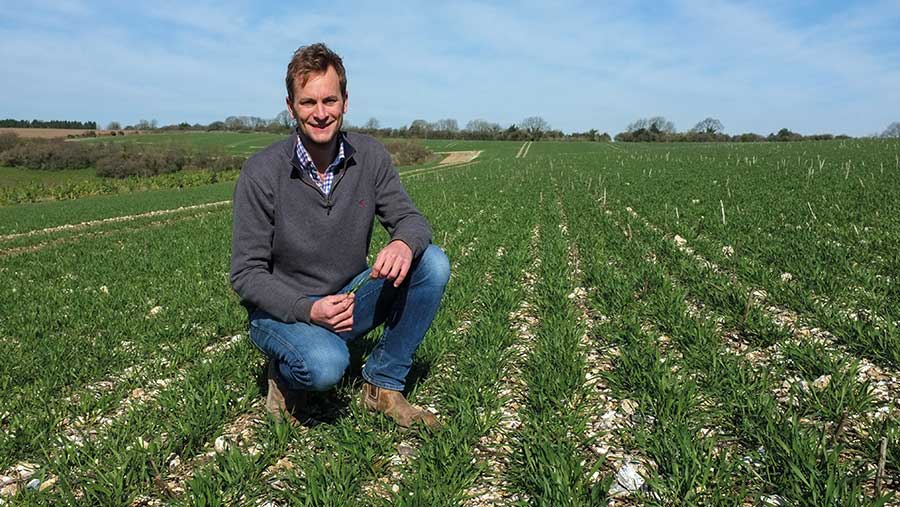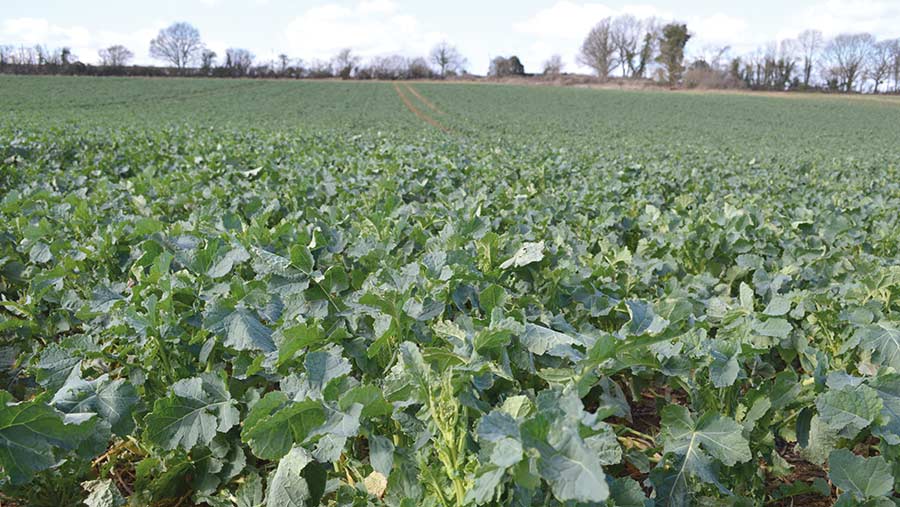Oilseed rape grower cuts back 20% on expensive nitrogen
 © AHDB
© AHDB Wiltshire oilseed rape grower Ben Jeans is looking to cut back 20% on his use of nitrogen fertiliser this spring due to its escalating price and still hopes to be close to his five-year average rapeseed yield.
The farm grows winter wheat, barley and oilseed rape, in addition to grass and maize for the cattle on chalky loam soils around the village of Broad Chalke, about 8 miles south-west of Salisbury.
After assessing the growth of his 127ha of oilseed rape coming out of winter, he is looking to trim back from his usual farm approach of applying 200kg/ha of nitrogen in two splits.
His aim is to save money and, hopefully, use the fertiliser more efficiently.
“With the current price of nitrogen, it makes sense to try and cut back on fertiliser, and hopefully not reduce the yield too much,” he tells Farmers Weekly.
See also: Large oilseed rape crops may need less costly nitrogen
Application system
He measured the green area index (GAI) of his crops between a pigeon-ravaged field at 0.6 up to others at 1.8, and so will reduce his ammonium nitrate applications to between 150kg/ha and 175kg/ha in two splits this season.
The GAI value was assessed by using a BASF app on his mobile phone, and each GAI unit represents 50kg/ha of nitrogen already in the growing crop.
The reduction in nitrogen for Mr Jeans’ crops will be spread evenly over the two early applications, with the first split applied in mid- to late February and the second due to go on in late March.
He will keep sulphur and magnesium inputs as usual.
His oilseed rape crops got off to a good start on the 830ha family-run mixed Chalk Pyt Farm.
Farmyard manure or slurry from the 180-strong Holstein dairy herd is spread after winter or spring barley is cut, and then oilseed rape is direct drilled with a tined Horsch Sprinter.
Establishment and varieties
He carries out a relatively inexpensive establishment method.
No seed-bed fertiliser is used, there is a focus on home-saved conventional seed and no pre-emergence herbicides are applied.
This system has produced a five-year average yield of 3.6t/ha in a one-in-four-year rotation.
Mr Jeans favours conventional varieties, such as Campus and Aardvark, as they are relatively inexpensive if cabbage stem flea beetle does decimate a crop.
He grows the variety Aspire, for its turnip yellows virus (TuYV) resistance, on lower ground where disease-spreading aphids are more likely.
Sarah Kendall, crop physiologist at consultant Adas, says growers have the potential to reduce nitrogen this spring after generally good crop establishment in the autumn and lower cabbage stem flea beetle numbers.
She adds that the soil nitrogen supply is higher than normal this spring due to warmer winter temperatures. These led to more mineralisation of nitrogen in the soil and less leaching in a dry winter.
“Large crop canopies do not need early nitrogen and it is acceptable for some crops not to get any until late March, and not result in a significant fall in yields,” she says.
Small yield reduction
Dr Kendall points out that with ammonium nitrate at £690/t and rapeseed at a conservative £500/t, growers could reduce nitrogen fertiliser by 50kg/ha and only suffer a yield reduction of 0.2t/ha.
She adds that to get to the optimum GAI at 3.5 at flowering an oilseed rape crop needs 175kg/ha of nitrogen to build a good canopy to produce an average yield of 3.5t/ha.
A well-advanced crop at GAI 3 will already have 150kg/ha of nitrogen in the crop, while if the soil provides another 25kg/ha then the crop may not need any nitrogen at all.
She points out that if reducing nitrogen, growers should still keep up sulphur levels.
“Even if growers are making reductions in nitrogen, then the sulphur requirement stays the same,” she says.

© MAG/David Jones
Resistant varieties
Mr Jeans’ choice of using a TuYV-resistant variety on his lower ground was given support by Steve Ellis, principal entomologist consultant at Adas.
“While we have got this resistance it is well worth making use of it,” says Dr Ellis.
The disease, which is spread by the peach potato aphid (Myzus persicae), can give yield losses of up to 30%, and gives symptoms of reddening and purpling of leaf margins – signs that are not easily recognised until stem extension.
Chemical control is expensive as the aphids are resistant to most insecticides, including the relatively inexpensive pyrethroids.
The only control is from pymetrozine (Plenum) and flonicamid (Teppeki), and these can only be used once a season, so timing can be critical.
The aphids move into oilseed rape crops in September/October from other crops such as brassicas, sugar beet, potatoes and lettuce.
Therefore, the array of varieties that are resistant are very useful and these include hybrids such as Aurelia, Auckland and PT303, as well as conventional ones, such as Aspire.
All the speakers were attending an AHDB Salisbury Monitor Farm meeting held in late February.

